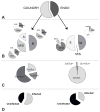A cryptic subgroup of Anopheles gambiae is highly susceptible to human malaria parasites
- PMID: 21292978
- PMCID: PMC3065189
- DOI: 10.1126/science.1196759
A cryptic subgroup of Anopheles gambiae is highly susceptible to human malaria parasites
Abstract
Population subgroups of the African malaria vector Anopheles gambiae have not been comprehensively characterized owing to the lack of unbiased sampling methods. In the arid savanna zone of West Africa, where potential oviposition sites are scarce, widespread collection from larval pools in the peridomestic human habitat yielded a comprehensive genetic survey of local A. gambiae population subgroups, independent of adult resting behavior and ecological preference. A previously unknown subgroup of exophilic A. gambiae is sympatric with the known endophilic A. gambiae in this region. The exophilic subgroup is abundant, lacks differentiation into M and S molecular forms, and is highly susceptible to infection with wild Plasmodium falciparum. These findings might have implications for the epidemiology of malaria transmission and control.
Figures



Comment in
-
New mosquito subgroup breeds questions.Science. 2011 Apr 22;332(6028):419-20; author reply 420-1. doi: 10.1126/science.332.6028.419-b. Science. 2011. PMID: 21512019 No abstract available.
References
-
- Pates H, Curtis C. Mosquito behavior and vector control. Annu Rev Entomol. 2005;50:53. - PubMed
-
- Service MW. Mosquito ecology: Field sampling methods. 2. Chapman & Hall; London: 1993.
-
- Coluzzi M, Sabatini A, Petrarca V, Di Deco MA. Behavioural divergences between mosquitoes with different inversion karyotypes in polymorphic populations of the Anopheles gambiae complex. Nature. 1977;266:832. - PubMed
Publication types
MeSH terms
Grants and funding
LinkOut - more resources
Full Text Sources
Other Literature Sources

